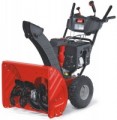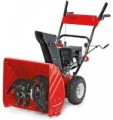Working width
The width of the strip of snow that the snow blower can clear in one pass. The larger the capture width, the fewer passes will be required to process the site, which is especially important on large areas. On the other hand, for processing small spaces, clearing individual paths, etc. significant width is not required (moreover, a “narrow” snow blower will pass more easily in a hard-to-reach place). The larger the capture width, the more powerful the engine, usually, ceteris paribus.
The most compact modern snow blowers have a working width of
less than 50 cm, these are mainly electric models of low power, although gasoline units are also found. A width of
50 – 60 cm can be called relatively small,
60 – 70 cm — medium, and in the largest models this figure
exceeds 70 cm.
Design
—
Self-propelled design. In self-propelled snow blowers, the built-in motor drives not only the auger, but also the wheels / tracks, ensuring the movement of the device. In this way, you do not have to push the snow blower by hand, which makes work much easier — especially with heavy, powerful models. Most self-propelled models have a transmission that allows you to adjust the speed of movement, as well as the ability to move backward (see "Number of gears").
—
Overload protection. A safety system that protects the unit from breakdowns in the event of critical loads. The main reason for the occurrence of such loads is the jamming of the screw — for example, due to the ingress of a foreign object. Therefore, most often, special bolts are used for protection, connecting the auger to the motor gearbox: with a sharp increase in load, the bolts are cut off and the auger is disconnected from the gearbox. Another option is overheating protection that reacts to engine temperature; it is found predominantly in electrical assemblies and can be used alone or in combination with shear bolts.
—
Headlights. The presence of a headlight (headlights) in the design of the snow blower allows you to use it for work at night, when there are no other light sources or they are not enough. In addition, in some models, the headlights turn on automatically every time the engine is starte
...d — they play the role of a warning signal that the unit is running.
— Heated handles. Heating system for handles, which the operator holds during work. This feature is especially useful as snow blowers are used in cold weather, and hands can get cold during prolonged use. On the other hand, with small volumes of cleaning, you can completely do with gloves, so heated handles are found mainly in powerful models with internal combustion engines, designed for large volumes of work.Number of gears
The number of gears in the transmission of a self-propelled snow blower (see "Design"), in fact — the number of speeds at which it can move during operation.
Recall that upshifting increases speed and reduces torque. Thus, high gears are convenient for working with loose snow, which does not give strong resistance, while low gears allow you to cope with dense snow and crust. And the greater the number of gears, other things being equal, the more accurately you can choose the optimal speed. On the other hand, the abundance of settings complicates and increases the cost of the transmission. Therefore, when choosing the number of gears, manufacturers also take into account the overall level of the snow blower: the more powerful and heavier the unit, the more settings it usually provides.
A separate case are units with continuously variable (including hydrostatic) transmissions. They do not have fixed gears, and the gear ratio is automatically adjusted depending on the throttle position and the load on the working nozzle. One of the advantages of such systems is the almost zero probability of slipping, because. the wheels keep the torque at all times. In addition, the transmission itself can play the role of overload protection: when the auger is jammed, it disconnects it from the engine. On the other hand, stepless systems are quite complex and expensive, and automation does not always work exactly the way the user wants; therefore, this option is relatively rare.
Motor type
Model of the engine installed in the snow blower.
With this information, you can find detailed data on the engine — from official specifications to reviews, reviews and advice on specific nuances. In this way, you can evaluate how a snow blower with this particular engine will suit your needs.
Engine size
The size of the engine installed in a gasoline or diesel (see "Engine type") snow blower. With the same type of internal combustion engine (see above), more displacement usually means more power and more fuel consumption.
Motor power
Snowblower engine power in horsepower.
The universal unit of power today is watts, but for gasoline and diesel engines (see "Engine type"), the traditional designation in horsepower may also be given. 1 HP approximately equal to 735 watts.
The higher the engine power, the higher the performance of the snow blower, the better it handles with high dense snowdrifts and icy crust. However, more powerful engines consume more fuel, weigh more and cost more, and their use is not always justified. Detailed recommendations on choosing the optimal power for a specific situation can be found in special sources.
Motor power
Snow blower motor power in watts. This designation applies to all electrical models; for units with internal combustion engines (see "Engine type"), the designation in horsepower (see above) may also be given.
The higher the engine power, the higher the performance of the snow blower, the better it handles with high dense snowdrifts and icy crust. However, more powerful engines consume more fuel, weigh more and cost more, and their use is not always justified. Detailed recommendations on choosing the optimal power for a specific situation can be found in special sources.
Launch type
Method of starting the engine of a gasoline (see "Engine type") snow blower. To date, there are such options:
— Manual (cable). The simplest way to start: the operator pulls the cable, which scrolls the shaft and gives the engine the necessary initial impulse. Such launch systems are as compact, simple and inexpensive as possible, moreover, they do not depend on power sources. On the other hand, it makes sense to use cables mainly in light and low-power snow blowers — to start heavy units, significant effort is required, which is easier to provide with an electric starter.
—
Electric starter (230 V network). Starting with an electric starter powered by a 230 V network (ordinary socket). An electric starter is a small electric motor that, when started, rotates the engine shaft, giving it an initial impulse. Such systems are more complex, heavier and more expensive than cables, but they are suitable for even the heaviest and most powerful engines; and the launch itself is extremely simple — the user only needs to press a button. At the same time, mains power allows you to do without heavy and expensive batteries. However the network itself is required to start, but most often there are no special problems with this; and in case the snow blower stalls “in an open field”, a spare launch system is usually provided in the form of the same cable. Therefore, most units with electric starters use mains power.
—
...ef="/list/71/pr-35151/">Electric starter (battery). Starting with an electric starter powered by a battery installed in the snow blower. See above for the general features of electric starters, and battery power makes the starting system as autonomous as possible: the starter can be used regardless of the presence of outlets nearby, and the battery is recharged from a running engine if necessary. On the other hand, the presence of a battery affects the cost and weight of the unit, and the mentioned battery life is required relatively infrequently. Therefore, battery-powered electric starters are used only in certain models of high-performance snowplows, designed for long-term operation "in the field", away from the mains; the weight and price of the battery in such cases are insignificant compared to the weight and price of the unit itself.
Fuel tank volume
The amount of fuel that the snow blower tank can hold at one time. Knowing this figure, as well as fuel consumption (see above), you can easily calculate the approximate operating time on one gas station. However, manufacturers usually choose the volume so that the operating time reaches at least 2 – 2.5 hours, so in most cases you can not pay much attention to this parameter.

